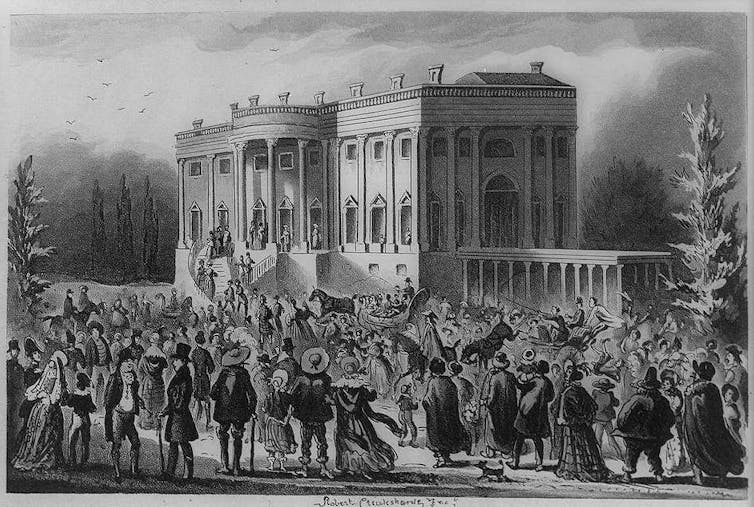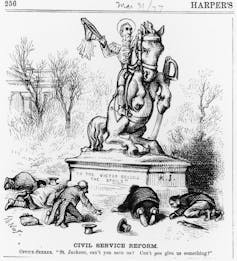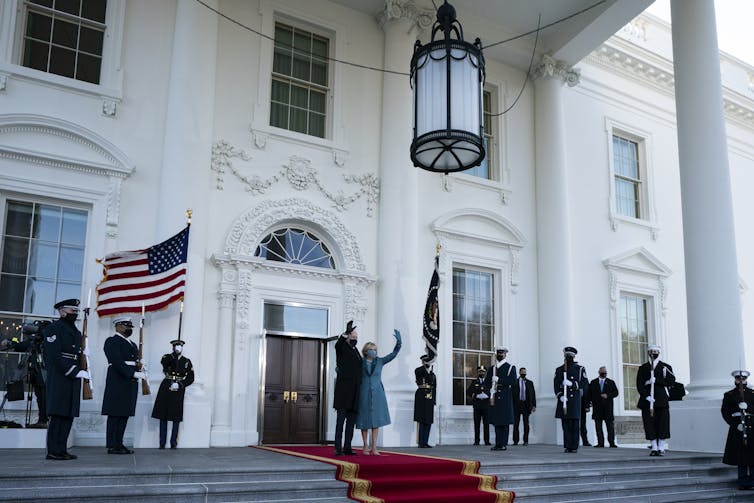Trump revived Andrew Jackson's spoils system, which would undo America's 138-year-old professional civil service
- Written by Barry M. Mitnick, Professor of Business Administration and of Public and International Affairs, University of Pittsburgh
The federal government’s core civilian workforce has long been known for its professionalism[1]. About 2.1 million nonpartisan career officials[2] provide essential public services in such diverse areas as agriculture, national parks, defense, homeland security, environmental protection and veterans affairs.
To get the vast majority of these “competitive service” jobs – which are protected from easy firing – federal employees must demonstrate achievement in job-specific knowledge, skills and abilities superior to other applicants[3] and, in some cases, pass an exam. In other words, the civil service is designed to be “merit-based[4].”
It wasn’t always so.
From Andrew Jackson until Theodore Roosevelt, much of the federal workforce was subject to change after every presidential election[5] – and often did. Known as the spoils system, this pattern of political patronage, in which officeholders award allies with jobs in return for support, began to end[6] in the late 19th century as citizens and politicians like Roosevelt grew fed up with its corruption, incompetence and inefficiency[7] – and its role in the assassination of a president[8].
Less than two weeks before Election Day, Donald Trump signed an executive order that threatens[9] to return the U.S. to a spoils system in which a large share of the federal government’s workforce could be fired for little or no reason – including a perceived lack of loyalty to the president.
While President Joe Biden appears likely to reverse the order[10], its effects may not be so easily undone. And he may have his own reasons for keeping it temporarily in place.
 People seeking government jobs crashed the White House on the day of Andrew Jackson’s inauguration.
Library of Congress[11]
People seeking government jobs crashed the White House on the day of Andrew Jackson’s inauguration.
Library of Congress[11]
Birth of the spoils system
The government of the early republic was small[12], but the issue of whether civil servants should be chosen on the basis of patronage or skills was hotly debated.
Although George Washington and the five presidents who followed him certainly employed patronage[13], they emphasized merit[14] when making appointments.
Washington wrote that relying on one’s personal relationship to the applicant would constitute[15] “an absolute bar to preferment” and wanted those “as in my judgment shall be the best qualified to discharge the functions of the departments to which they shall be appointed.” He would not even appoint[16] his own soldiers to government positions if they lacked the necessary qualifications.
That changed in 1829 when Andrew Jackson, the seventh president, entered the White House.
 Political cartoon by Thomas Nast depicts office seekers seeking jobs from Andrew Jackson.
Fotosearch/Getty Images[17]
Political cartoon by Thomas Nast depicts office seekers seeking jobs from Andrew Jackson.
Fotosearch/Getty Images[17]
Jackson came to office as a reformer[18] with a promise to end the dominance of elites and what he considered their corrupt policies. He believed that popular access to government jobs – and their frequent turnover through a four-year “rotation in office[19]” – could serve ideals of democratic participation, regardless of one’s qualifications for a position.
As a result, at his inaugural reception on March 4, a huge crowd of office seekers crashed[20] the reception. Jackson was “besieged by applicants” and “battalions of hopefuls,” all seeking government jobs[21].
Instead of preventing corruption from taking root, Jackson’s rotation policy became an opportunity for patronage[22] – or rewarding supporters with the spoils of victory. He defended the practice[23] by declaring: “If my personal friends are qualified and patriotic, why should I not be permitted to bestow a few offices on them?”
Besides possessing a lack of appropriate skills and commitment[24], office seekers were expected to pay “assessments”[25] – a percentage of their salary ranging from 2% to 7% – to the party that appointed them.
Although Jackson replaced only about 10%[26] of the federal workforce and 41% of presidential appointments, the practice increasingly became the norm[27] as subsequent presidents fired as well as refused to reappoint ever-larger shares of the government.
The peak of the spoils system came under James Buchanan, who served from 1857 to 1861. He replaced[28] virtually every federal worker at the end of their “rotation.”[29] William L. Marcy, who was secretary of state under Buchanan’s predecessor and was the first to refer to patronage as “spoils,” wrote in 1857[30] that civil servants from his administration were being “hunted down like wild beasts.”
Even Abraham Lincoln, who followed Buchanan, made extensive use of the system, replacing at least 1,457 of the 1,639 officials[31] then subject to presidential appointment. The number would have been higher but for the secession of Southern states, which put some federal officials out of his reach.
A ‘vast public evil’ comes to an end
The tide began to turn in the late 1860s following public revelations[32] that positions had been created requiring little or no work and other abuses, including illiterate appointees[33], and a congressional report about the success[34] of civil service systems in Great Britain, China, France and Prussia.
In 1870, President Ulysses S. Grant asked Congress to take action, complaining,[35] “The present system does not secure the best men, and often not even fit men, for public place.” Congress responded with legislation that authorized the president to use executive orders to prescribe regulations for the civil service. That power exists today, most recently exercised in Trump’s own order.
Grant established a Civil Service Commission that led to some reforms, but just two years later a hostile Congress cut off new funding[36], and Grant terminated the experiment in March 1875. The number of jobs potentially open to patronage continued to soar, doubling from 51,020 in 1871 to 100,020 in 1881[37].
But across the U.S., citizens were becoming disgusted[38] by a government stuffed with the people known as “spoilsmen,” leading to a growing reform movement[39]. The assassination of President James Garfield in 1881 by a deranged office seeker[40] who felt Garfield had denied him the Paris diplomatic post he wanted pushed the movement over the edge.
Garfield’s murder was widely blamed[41] on the spoils system. George William Curtis, editor of Harper’s Weekly and an advocate for reform, published cartoons lambasting the system[42] and called it “a vast public evil.”
In early 1883, immediately after an election that led to sweeping gains for politicians in favor of reform, Congress passed the Pendleton Act[43]. It created the Civil Service System of merit-based selection and promotion. The act banned “assessments,” implemented competitive exams and open competitions for jobs, and prevented civil servants from being fired for political reasons.
 Teddy Roosevelt helped end the spoils system.
AP Photo/Jacquelyn Martin[44]
Teddy Roosevelt helped end the spoils system.
AP Photo/Jacquelyn Martin[44]
Roosevelt was appointed to the new commission that oversaw the system by President Benjamin Harrison in 1889 and quickly became its driving force[45] – even as Harrison himself abused the spoils system, replacing 43,823 out of 58,623 postmasters[46], for example.
At first, the system covered just 10.5% of the federal workforce[47], but it was gradually expanded to cover most workers. Under Roosevelt, who became president in 1901 after William McKinley was assassinated, the number of covered employees finally exceeded those not covered[48] in 1904 and soon reached almost two-thirds of all federal jobs[49]. At its peak in the 1950s, the competitive civil service covered almost 90% of federal employees[50].
New York, where Roosevelt was an assemblyman, and Massachusetts were the first states to implement their own civil service systems. Although all states now have such systems in place at local, state or both levels, it was not until after 1940 that most states adopted a competitive civil service[51].
A return to the spoils?
Trump’s executive order would mark a significant change.
The Oct. 21 order created a new category of the civil service workforce[52], known as “Schedule F,” which would include all currently protected employees in career positions that have a “confidential, policy-determining, policy-making or policy-advocating character.” Because the language is both vague and encompassing, it may apply to as many as hundreds of thousands of the 2.1 million federal civilian workers – potentially to every worker who has any discretion in giving advice or making decisions.
The first agency to report a list of covered workers, the Office of Management and Budget, identified 425 professionals[53] – 88% of its employees – as transferable to Schedule F, which means they could be fired at will[54].
Although the order didn’t formally take effect until Jan. 19, some agencies had already taken actions consistent with it – including an apparent “purge[55]” of career employees deemed insufficiently loyal to Trump. But the Trump administration was unable to fully implement Schedule F[56] before Biden took over on Jan. 20.
 Will Biden make reversing the Trump order one of his early acts of office?
AP Photo/Alex Brandon[57]
Will Biden make reversing the Trump order one of his early acts of office?
AP Photo/Alex Brandon[57]
Of course, Biden could quickly reverse the order – and there’s already a bipartisan push to forbid these transfers[58] – but rehiring anyone who has been fired won’t be easy or immediate.
Furthermore, Trump had tried to “burrow” political appointees deep into the senior executive service[59], the top level of the civil service. The burrowing included the controversial appointment[60] of Michael Ellis as general counsel of the National Security Agency. Senior executive service rules permit some political appointees to be converted to civil servants. This could protect them from easily being removed by Biden.
[Deep knowledge, daily. Sign up for The Conversation’s newsletter[61].]
Biden may want to remove civil servants considered Trump loyalists who may try to subvert his policies. If so, he’ll have to keep the executive order in place to expedite the process[62] and convert those employees to the new Schedule F classification, which would allow him to remove them. But keeping and using Schedule F, even for a relatively brief period, challenges the most fundamental principles of the civil service.
Trump’s order and Biden’s dilemma show that Teddy Roosevelt’s work is still unfinished. If, on a whim, a president can undo over a century of reforms, then the civil service remains insufficiently insulated from politics and patronage. It may be time Congress passed a new law that permanently shields one of America’s proudest achievements from becoming another dysfunctional part of the U.S. government.
References
- ^ known for its professionalism (catalog.hathitrust.org)
- ^ 2.1 million nonpartisan career officials (fas.org)
- ^ demonstrate achievement in job-specific knowledge, skills and abilities superior to other applicants (www.opm.gov)
- ^ merit-based (www.govexec.com)
- ^ federal workforce was subject to change after every presidential election (doi.org)
- ^ began to end (doi.org)
- ^ corruption, incompetence and inefficiency (www.jstor.org)
- ^ assassination of a president (www.nps.gov)
- ^ signed an executive order that threatens (www.govexec.com)
- ^ likely to reverse the order (www.washingtonpost.com)
- ^ Library of Congress (picryl.com)
- ^ was small (www.brookings.edu)
- ^ certainly employed patronage (doi.org)
- ^ they emphasized merit (books.google.com)
- ^ would constitute (doi.org)
- ^ He would not even appoint (doi.org)
- ^ Fotosearch/Getty Images (www.gettyimages.com)
- ^ as a reformer (jhupbooks.press.jhu.edu)
- ^ rotation in office (jhupbooks.press.jhu.edu)
- ^ huge crowd of office seekers crashed (www.penguinrandomhouse.com)
- ^ all seeking government jobs (www.penguinrandomhouse.com)
- ^ rotation policy became an opportunity for patronage (www.google.com)
- ^ defended the practice (jhupbooks.press.jhu.edu)
- ^ lack of appropriate skills and commitment (www.jstor.org)
- ^ were expected to pay “assessments” (doi.org)
- ^ replaced only about 10% (jhupbooks.press.jhu.edu)
- ^ became the norm (www.google.com)
- ^ replaced (books.google.com)
- ^ virtually every federal worker at the end of their “rotation.” (catalog.hathitrust.org)
- ^ wrote in 1857 (www.worldcat.org)
- ^ replacing at least 1,457 of the 1,639 officials (www.google.com)
- ^ public revelations (books.google.com)
- ^ illiterate appointees (www.worldcat.org)
- ^ congressional report about the success (books.google.com)
- ^ complaining, (books.google.com)
- ^ hostile Congress cut off new funding (books.google.com)
- ^ doubling from 51,020 in 1871 to 100,020 in 1881 (www.census.gov)
- ^ citizens were becoming disgusted (ufdc.ufl.edu)
- ^ growing reform movement (doi.org)
- ^ by a deranged office seeker (www.nps.gov)
- ^ was widely blamed (doi.org)
- ^ lambasting the system (books.google.com)
- ^ Congress passed the Pendleton Act (catalog.hathitrust.org)
- ^ AP Photo/Jacquelyn Martin (newsroom.ap.org)
- ^ became its driving force (www.opm.gov)
- ^ replacing 43,823 out of 58,623 postmasters (kansaspress.ku.edu)
- ^ covered just 10.5% of the federal workforce (ufdc.ufl.edu)
- ^ finally exceeded those not covered (www.opm.gov)
- ^ almost two-thirds of all federal jobs (ufdc.ufl.edu)
- ^ covered almost 90% of federal employees (ufdc.ufl.edu)
- ^ after 1940 that most states adopted a competitive civil service (doi.org)
- ^ created a new category of the civil service workforce (freerepublic.com)
- ^ identified 425 professionals (www.washingtonpost.com)
- ^ they could be fired at will (www.govexec.com)
- ^ purge (www.washingtonpost.com)
- ^ unable to fully implement Schedule F (www.washingtonpost.com)
- ^ AP Photo/Alex Brandon (newsroom.ap.org)
- ^ there’s already a bipartisan push to forbid these transfers (fitzpatrick.house.gov)
- ^ tried to “burrow” political appointees deep into the senior executive service (www.propublica.org)
- ^ controversial appointment (www.nytimes.com)
- ^ Sign up for The Conversation’s newsletter (theconversation.com)
- ^ have to keep the executive order in place to expedite the process (www.govexec.com)
Authors: Barry M. Mitnick, Professor of Business Administration and of Public and International Affairs, University of Pittsburgh

